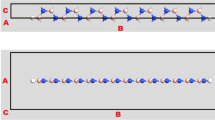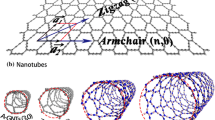Abstract
In this work, we have systematically investigated the structural, electronic, and optical absorption properties of the boron nitride (BN) adamantane isomers (B\(_x\)N\(_{10-x}\), with x= 4, 5 or 6), using both DFT and TD-DFT methods. These isomers were built by replacing carbon atoms of the adamantane molecule by boron and nitrogen atoms and keeping all isomers in closed-shell electronic configuration. Optimized nanostructures indicate that these BN adamantane exhibit good stability. In addition, the current study indicates that the new BN-isomers have an excellent absorption in the UV-C region, and a moderate absorption in the UV-B and UV-A regions. These characteristics enable this new BN adamantane as potential candidates to be used in the development of new nano-optoelectronic devices.









Similar content being viewed by others
References
M.S. Dresselhaus, M. Torrones, Carbon-based nanomaterials from a historical perspective. Proc. IEEE. 101(7), 1522–1535 (2013)
Y. Hu, O.A. Shenderova, Z. Hu et al., Carbon nanostructures for advanced composites. Rep. Prog. Phys. 69, 1847–1895 (2006)
Y. Zhou, A.D. Brittain, D. Kong et al., Derivatization of diamondoids for functional applications. J. Mater. Chem. C. 3(27), 6947–6961 (2015)
M. Schoell, R.M.K. Carlson, Diamondoids and oil are not forever. Nature. 399, 15–16 (1999)
S. Lee, M.H. Seo, Synthesis and electro-optical properties of adamantane-based host and hole-transporting material for thermal stable blue phosphorescent OLEDs. J. Nanosci. Nanotechnol. 17(10), 7292–7296 (2017)
G.A. Mansoori, Diamondoid molecules. Adv. Chem.Phys. 136, 207–258 (2007)
V.N. Mochalin, I. Neitzel, B.J.M. Etzold et al., Covalent incorporation of aminated nanodiamond into an epoxy polymer network. ACS Nano. 5(9), 7494–7502 (2011)
V.N. Mochalin, O. Shenderova, D. Ho et al., The properties and applications of nanodiamonds. Nat. Nanotech. 7, 11–23 (2012)
M.A. Gunawan, J.-C. Hierso, D. Poinsot et al., Diamondoids: functionalization and subsequent applications of perfectly defined molecular cage hydrocarbons. New J. Chem. 38(1), 28–41 (2014)
A.A. Fokin, R.I. Yurchenko, B.A. Tkachenko et al., Selective preparation of diamondoid phosphonates. J. Org. Chem. 79, 5369–5373 (2014)
J.E. Dahl, S.G. Liu, R.M.K. Carlson, Isolation and structure of higher diamondoids, nanometer-sized diamond molecules. Science. 299(5603), 96–99 (2003)
G.C. McIntosh, M. Yoon, S. Berber et al., Diamond fragments as building blocks of functional nanostructures. Phys. Rev. B. 70, 045401 (2004)
N.D. Drummond, A.J. Williamson, R.J. Needs et al., Electron emission from diamondoids: a diffusion quantum Monte Carlo study. Phys. Rev. Lett. 95, 096801 (2005)
A.J. Lu, B.C. Pan, J.G. Han, Electronic and vibrational properties of diamondlike hydrocarbons. Phys. Rev. B. 72, 035447 (2005)
T. Sasagawa, Z.-X. Shen, A route to tunable direct band-gap diamond devices: electronic structures of nanodiamond crystals. J. Appl. Phys. 104(7), 073704 (2008)
A.A. Fokin, P.R. Schreiner, Band gap tuning in nanodiamonds: first principle computational studies. Mol. Phys. 107(8–12), 823–830 (2009)
T. Demján, M. Voros, M. Palummo et al., Electronic and optical properties of pure and modified diamondoids studied by many-body perturbation theory and time-dependent density functional theory. J. Chem. Phys. 141(6), 064308 (2014)
F. Marsusi, K. Mirabbaszadeh, G.A. Mansoori, Opto-electronic properties of adamantane and hydrogen terminated sila- and germa-adamantane: a comparative study. Physica E. 41(7), 1151–1156 (2009)
L. Landt, K. Klünder, J.E. Dahl et al., Optical response of diamond nanocrystals as a function of particle size, shape, and symmetry. Phys. Rev. Lett. 103, 047402 (2009)
W.L. Yang, J.D. Fabbri, T.M. Willey et al., Monochromatic electron photoemission from diamondoid monolayers. Science. 316(5830), 1460–1462 (2007)
T. Maugh, Panel urges wide use of antiviral drug. Science. 206(4422), 1058–1060 (1979)
A. Hurt, N. Komadina, Y.-M. Deng et al., Detection of adamantane-sensitive influenza A(H3N2) viruses in Australia, 2017: a cause for hope? Euro Surveill. 22(47), 1–8 (2017)
T.A. Blanpied, R.J. Clarke, J.W. Johnson, Amantadine inhibits NMDA receptors by accelerating channel closure during channel block. J. Neurosci. 25(13), 3312–3322 (2005)
A. Štimac, M. Šekutor, K. Mlinarić-Majerski et al., Molecules. 22(2), 297 (2017)
M.A. Abdulsattar, Modeling the electronic, structural and vibrational properties of cubic SiC nanocrystals built from diamondoid structures. Silicon. 8(2), 239–244 (2016)
Y.-D. Song, L. Wang, L.-M. Wu, The structures and nonlinear optical responses of Li/Na doped adamantane: A density functional study. Optik. 127(22), 10825–10837 (2016)
H.M. Abduljalil, M.A. Abdulsattar, Structural and spectroscopic properties of AlP diamondoids: a DFT study. J. Eng. Appl.Sci. 13(12), 4381–4386 (2018)
H.M. Abduljalil, M.K. Khaleel, Study of the geometrical optimization and energy gap of AlAs diamondoids. JUBPAS 25(3), 1000–1009 (2017)
H.M. Abduljalil, M.A. Abdulsattar, N.A.-H.T. Al-Aaraji, Optimization parameters and some electronic properties of AlSb diamondoids: a density function theory study. JUBPAS 26(6), 77–83 (2018)
M.A. Abdulsattar, H.M. Abduljalil, H.H. Abed, Formation energies of CdSe wurtzoid and diamondoid clusters formed from Cd and Se atomic clusters. Calphad 64, 37–42 (2019)
B.B. Kadhim, M.A. Abdulsattar, A.M. Ali, Quantum confinement effects of formation energies and vibrational properties of CdS clusters: A DFT study. Int. J. Mod. Phys. B 33(16), 1950163-1–1950163-11 (2019)
H. Sharma, B. Saha, P.K. Bhattacharyya, Sandwiches of N-doped diamondoids and benzene via lone pair-cation and cation-pi interaction: a DFT study. New J. Chem. 41(23), 14420–14430 (2017)
N. Kutsumura, R. Ohshita, J. Horiuchi et al., Synthesis of heterocyclic compounds with adamantane-like cage structures consisting of phosphorus, sulfur, and carbon. Tetrahedron. 73(34), 5214–5219 (2017)
W.D.S.A. Miranda, S.S. Coutinho, M.S. Tavares et al., Ab initio vibrational and thermodynamic properties of adamantane, sila-adamantane (Si10H16), and C9Si1H16 isomers. J. Mol. Struc. 1122, 299–308 (2016)
J.C. Garcia, J.F. Justo, W.V.M. Machado et al., Functionalized adamantane: building blocks for nanostructure self-assembly. Phys. Rev. B. 80(12), 125421 (2009)
J.C. Garcia, J.F. Justo, W.V.M. Machado et al., Boron and nitrogen functionalized diamondoids: a first principles investigation. Diamond Relat. Mater. 19(7–9), 837–840 (2009)
Y. Fan, M. Zhao, T. He et al., Electronic properties of BN/C nanotube heterostructures. J. Appl. Phys. 107(9), 094304 (2010)
M. Xiong, K. Luo, D. Yu et al., Pressure-induced boron nitride nanotube derivatives: 3D metastable allotropes. J. Appl. Phys. 121(16), 165106 (2017)
M. Machado, P. Piquini, R. Mota, Electronic properties of selected BN nanocones. Mater. Charact. 50(2), 179–182 (2003)
C. Zhi, Y. Bando, C. Tang et al., Electronic structure of boron nitride cone-shaped nanostructures. Phys. Rev. B. 72(24), 245419 (2005)
Y. Tian, R. Wei, V. Eichhorn et al., Mechanical properties of boron nitride nanocones. J. Appl. Phys. 111(10), 104316 (1997)
G. Seifert, P.W. Fowler, D. Mitchell et al., Boron-nitrogen analogues of the fullerenes: electronic and structural properties. Chem. Phys. Lett. 268(5–6), 352–358 (1997)
V.V. Pokropivny, V.V. Skorokhod, G.S. Oleinik et al., Boron nitride analogs of fullerenes (the fulborenes), nanotubes, and fullerites (the fulborenites). J. Solid State Chem. 154(1), 214–222 (2000)
Y. Ohta, Possible mechanism of BN fullerene formation from a boron cluster: density-functional tight-binding molecular dynamics simulations. J. Comput. Chem. 37(10), 886–895 (2016)
S. Jianhao, Z. Tong, L. Xuechao et al., First-principles calculation on electronic properties of B and N co-doping carbon nanotubes. J. Semicond. 37(3), 032002 (2016)
K. Luo, X. Yuan, Z. Zhao et al., New hexagonal boron nitride polytypes with triple-layer periodicity. J. Appl. Phys. 121(16), 165102 (2017)
L. Liu, Y.P. Feng, Z.X. Shen, Structural and electronic properties of h-BN. Phys. Rev. B. 68(10), 104102 (2003)
M. Fyta, Stable boron nitride diamondoids as nanoscale materials. Nanotech. 25(36), 365601 (2014)
S. Sinthika, E.M. Kumar, V.J. Surya et al., Activation of CO and CO\(_2\) on homonuclear boron bonds of fullerene-like BN cages: first principles study. Sci. Rep. 5, 17460 (2015)
B. Delley, An all-electron numerical method for solving the local density functional for polyatomic molecules. J. Chem. Phys. 92(1), 508–517 (1990)
B. Delley, From molecules to solids with the DMol\(^{3}\) approach. J. Chem. Phys. 113(18), 7756–7764 (2000)
P. Hohenberg, W. Kohn, Inhomogeneous electron gas. Phys. Rev. 136(3B), B864–B871 (1964)
W. Kohn, L.J. Sham, Self-consistent equations including exchange and correlation effects. Phys. Rev. 140(4A), A1133–A1138 (1965)
R.O. Jones, O. Gunnarsson, The density functional formalism, its applications and prospects. Rev. Mod. Phys. 61(3), 689–746 (1989)
O.V. Gritsenko, P.R.T. Schipper, E.J. Baerends, Exchange and correlation energy in density functional theory: comparison of accurate density functional theory quantities with traditional Hartree-Fock based ones and generalized gradient approximations for the molecules Li\(_2\), N\(_2\), F\(_2\). J. Chem. Phys. 107(13), 5007–5015 (1997)
A. Dal Corso, A.A. Pasquarello, A. Baldereschi et al., Generalized-gradient approximations to density-functional theory: a comparative study for atoms and solids. Phys. Rev. B. 53(3), 1180–1185 (1996)
M. Fuchs, M. Bockstedte, E. Pehlke et al., Pseudopotential study of binding properties of solids within generalized gradient approximations: The role of core-valence exchange correlation. Phys. Rev. B. 57(4), 2134–2145 (1998)
J.P. Perdew, Y. Wang, Accurate and simple analytic representation of the electron-gas correlation energy. Phys. Rev. B. 45(23), 13244–13249 (1992)
D.M. Ceperley, B.J. Alder, Ground state of the electron gas by a stochastic method. Phys. Rev. Lett. 45(7), 566–569 (1980)
F.A. Hamprecht, A.J. Cohen, D.J. Tozer et al., Development and assessment of new exchange-correlation functionals. J. Chem. Phys. 109(15), 6264–6271 (1998)
A.D. Boese, N.L. Doltsinis, N.C. Handy et al., New generalized gradient approximation functionals. J. Chem. Phys. 112(4), 1670–1678 (2000)
A.D. Boese, N.C. Handy, A new parametrization of exchange-correlation generalized gradient approximation functionals. J. Chem. Phys. 114(13), 5497–5503 (2001)
B. Delley, Hardness conserving semilocal pseudopotentials. Phys. Rev. B. 66(15), 155125 (2002)
B. Delley, Time dependent density functional theory with DMol\(^{3}\). J. Phys. Condens. Matter. 22(38), 384208 (2010)
E.I. Bagrii, Adamantanes: synthesis, properties, applications (Nauka, Moscow, 1989). (in Russian)
J. Fischer, J. Baumgartner, C. Marschner, Synthesis and structure of sila-adamantane. Science. 310(5749), 825 (2005)
Ramachandran G, Manogaran S. Vibrational spectra of adamantanes X\(_{10}\)H\(_{16}\) and diamantanes X\(_{14}\)H\(_{20}\) (X = C, Si, Ge, Sn): a theoretical study. J. Mol. Struct. (Theochem). 2006;766:125-135
J.J.P. Stewart, MOPAC manual (seventh edition) (Colorado Springs, USA, Stewart Computational Chemistry, 2016)
I. Vasiliev, S. Öğüt, J.R. Chelikowsky, First-principles density-functional calculations for optical spectra of clusters and nanocrystals. Phys. Rev. B. 65(11), 115416 (2002)
Acknowledgements
The authors thank the State University of Maranhão (Chamada Interna 04/2017-PPG/UEMA) and the Maranhão Research Foundation–FAPEMA for financial support from FAPEMA projects: Universal–00795/15, Universal–00798/16, and Universal–01108/19. David L. Azevedo acknowledges the support of Mato Grosso Research Foundation–FAPEMAT through the Grant PRONEX CNPq/ FAPEMAT–850109/2009, Fundação de Amparo a Pesquisa do Distrito Federal - Edital 04/2017 - FAP/DF and CNPq (Edital 12/2017-PQ).
Author information
Authors and Affiliations
Corresponding author
Additional information
Publisher's Note
Springer Nature remains neutral with regard to jurisdictional claims in published maps and institutional affiliations.
Supplementary Information
Below is the link to the electronic supplementary material.
Rights and permissions
About this article
Cite this article
Miranda, W.D.S.A., Moreira, E., Tavares, M.S. et al. BN adamantane isomers: an optical absorption spectrum study. Appl. Phys. A 127, 32 (2021). https://doi.org/10.1007/s00339-020-04229-3
Received:
Accepted:
Published:
DOI: https://doi.org/10.1007/s00339-020-04229-3




